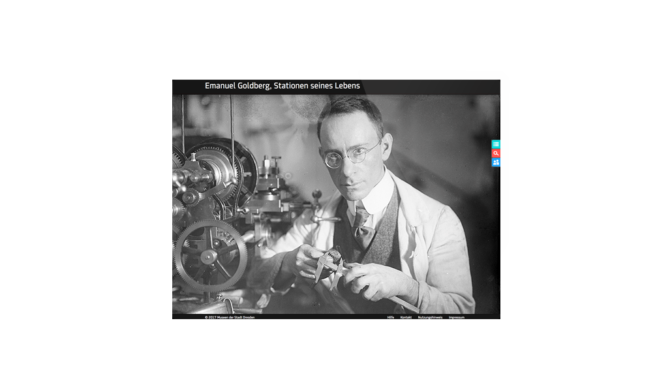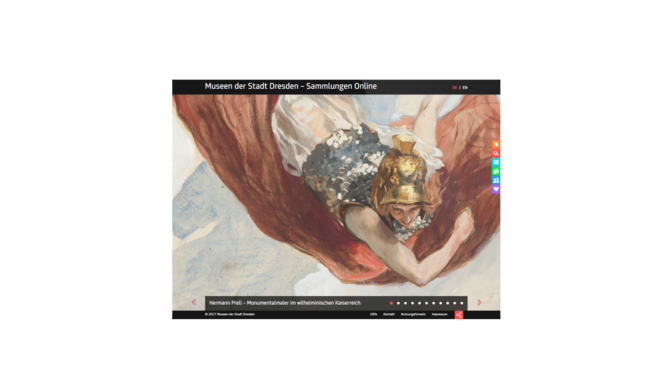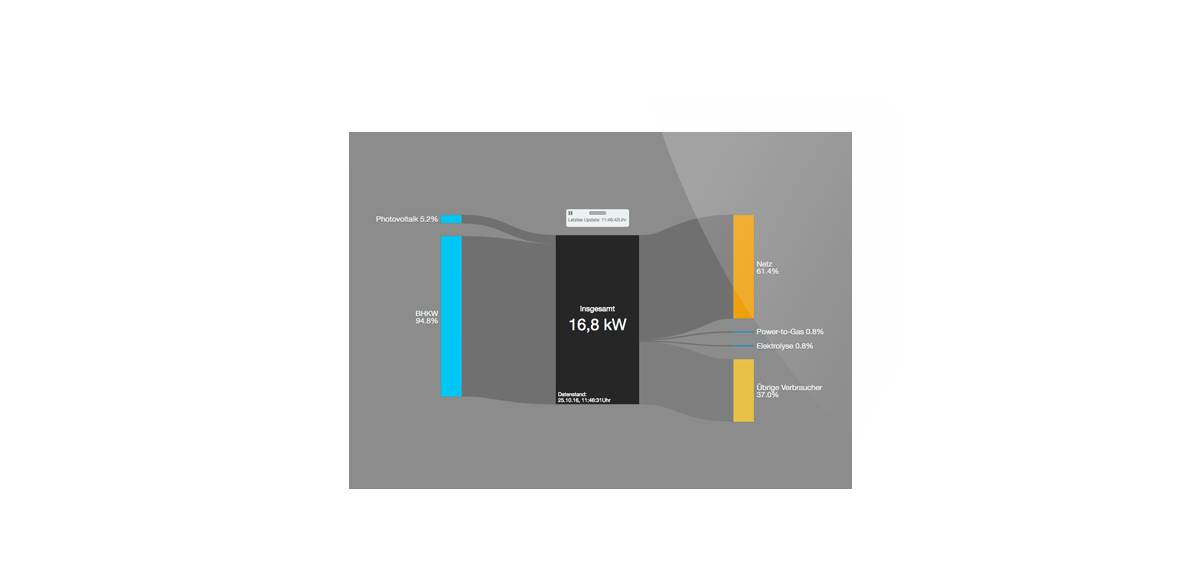Die Pflegeeinrichtungen der Diakonie Hamburg haben ein neues Jobportal: pflege-jobs.hamburg. Es richtet sich an Jobsuchende in der Altenpflege und bietet viele Informationen über freie Stellen, Arbeitgeber und Karrieremöglichkeiten.
Die Webseite haben wir für die Diakonie umgesetzt und wünschen viel Erfolg für die begleitende Kampagne.
Spendenportal
… english translation coming soon …
Museum display
For the museums in the city of Dresden we have created a collection database which acts as a virtual museum. In a temporary exhibition focusing on the Jewish inventor Emanuel Goldberg, who, amongst other achievements, was a co-founder of Zeiss Ikon, an adaptation of this application is being used as a kiosk system in the exhibition area. Here, visitors can access information about the exhibits during their visit. As a result, the collection database can be used for temporary events.
The web database’s interfaces can be set up cost effectively as a kiosk system for an exhibition project with relatively little effort. Based on the user interface’s modular structure, single functions in the collection database can be put together for temporary events as required. The data pertaining to the relevant works will then be linked with this adaptation.
Virtual museum
Dresden’s museums are part of an association of eight municipal museums in the regional capital of Saxony and look after the city’s art collection, objects pertaining to the city’s history and Saxony’s industrial and technological history. They represent the memory of civic Dresden and the region and document its varied history as silent witnesses. The collections comprise artworks and objects of all kinds. Paintings, graphics, sculptures and industrial objects, written documents and handicrafts.
For some time, these artefacts have been digitalized to present them on the internet to a wider audience. In the “virtual museum” thus created, users can become acquainted with the collections irrespective of where they are located, and follow up on what they have seen during a museum visit, thus deepening their knowledge. This expansion into the virtual world offers museums many attractive options. They can expand their reach, involve the interested public more and continue to build on their social significance. The creation of the collection database was put out to tender as part of an ideas competition by the museums of the city of Dresden. Our concept prevailed against three other competitors, winning the contract to implement the project.
The focus of our approach is always based on the current content, be it individual objects, curated object contexts or results of user inputs such as searches or assembling artefacts in collection folders. All the tool’s controls are arranged around the edges and can be folded out when needed. This provides the greatest amount of space possible for the objects to be displayed at full resolution and shown in the greatest detail. Depending on the context, further levels of detail with meta information, alternative views and contexts can be displayed.
It is possible to access the collection both by browsing and by taking a specific route. In addition to curated tours, access to the academic system, and a field-based filter, above all, the integrated live full text search offers immediate and simple access to the many thousands of objects that have lain dormant for years as undiscovered treasures in the archives, and which in future years will be available to public scrutiny.
U-Multirank – Noch mehr Möglichkeiten
Die vierte Ausgabe von U-Multirank ist seit heute online. Mit jetzt 16 Fächern und 1.500 Universitäten aus 99 Ländern ist U-Multirank das weltweit umfassendste Hochschul-Ranking. Wir waren wieder mit dabei und verantwortlich für Konzeption und Umsetzung des Webtools.
U-Multirank richtet sich an Studenten, Universitäten, Firmen sowie an die politischen Entscheider und bietet einen einzigartigen Überblick über die globale Hochschullandschaft.
Energie-Campus
Der Auftrag des Competence Center für Erneuerbare Energien und Energieeffizienz (CC4E) auf dem Energie-Campus der HAW Hamburg ist, nachhaltige Lösungen für die Energieprobleme der Gesellschaft zu entwickeln. Im Smart Grid-Labor der Einrichtung werden effiziente und intelligente Strategien im Zusammenspiel von Energieerzeugung,-verbrauch und -speicherung entwickelt und getestet. Im Rahmen des Hackathons „What The Data!?“ von Cybus und Dezera haben wir mit Reshin ein grundlegendes Monitoring der Energieflüsse im Haus aufgebaut.
Am Campus wird durch Photovoltaik und dem Blockheizkraftwerk Strom erzeugt. Wenn der aktuelle Verbrauch höher ist als die momentane Erzeugung, wird die Differenz über den Hausanschluss aus dem Stromnetz bezogen. Umgekehrt kann Strom in das öffentliche Netz eingespeist werden, sobald die momentane Erzeugung den aktuellen Bedarf übersteigt. Die Visualisierung zeigt live die aktuelle Relation von Bereitstellung und Verbrauch.
Die Daten des Energie-Campus werden von einer Cybus-Middleware ausgelesen und in einem MQTT-Broker bereitgestellt. Reshin abonniert die relevanten Topics des Broker, speichert sie für historischen Zugriff und bereitet sie für diverse Darstellungen auf.
TCloud
As part of a prototype project for Schneider-Neureuthner Partner AG (SNP), we have explored how complex information can be intuitively represented and used.
On behalf of its customers, SNP is carrying out SAP transformations, during which detailed insights into customer systems are required. In large companies, SAP systems create complex, linked structures which vary in different ways depending on the angle and task in hand. These structures cannot be easily illustrated with simple, tabular representations. Therefore, they do not facilitate intuitive access and do not demonstrate their effectiveness in the transformation process adequately.
We have implemented three measures in the prototype that allow structures to be represented more clearly and used more effectively:
- Using a modern, information-centred layout supports detecting relevant information quicker.
- Use-case oriented aggregations reduce the wealth of information and only present the details germane to the current task.
- Interactive tools structure the information separately for the respective context. They offer options for changing perspectives and for focusing on specific aspects of currently relevant structures.
Energy campus
The Competence Centre for Renewable Energies and Energy Efficiency (CC4E) located on the Energy Campus at HAW Hamburg is developing sustainable solutions for society’s energy problems. In a smart grid laboratory at the institution, efficient and intelligent strategies are being developed and tested to analyze the interaction of energy production, consumption and storage. As part of the hackathon “What the Data!?” hosted by Cybus and Dezera, we built a basic system for monitoring energy flows in house.
Electricity is generated on campus using photovoltaics and thermal power stations. If the current consumption is higher than the generation that moment, the difference is covered by the building connection to the electricity grid. On the other hand, electricity can be stored in the public grid as soon as the current generation exceeds actual use. Our live visualisation shows the current relationship between supply and consumption.
The energy campus data is read out using Cybus middleware and provided from a MQTT broker. Reshin subscribes to the relevant topics of the broker, stores them for historical access and uses them for various visualizations.
Hackathon What The Data!? – Wir machen mit!
Vom 23. bis 25. September 2016 findet der größte deutsche Industriehackathon in Hamburg statt, veranstaltet von Cybus und dem EnergieCampus Hamburg. Wir nehmen mit unserer Datenplattform Reshin teil und werden eine Realtime-Sicht auf die Anlagen des EnergieCampus entwickeln. Mit Hilfe dieser Sicht lassen sich wechselseitige Abhängigkeiten der Anlagen untersuchen, Optimierungspotentiale erkennen und sie dient als erster Einstieg in die weitergehende Analyse.
Folge 3 nimmt mit einem Team aus Produkt-Entwicklern, Designern, Daten-Analysten und Programmierern teil. Für den Hackathon nutzen wir unser Daten-Management-System Reshin, mit dem wir in kürzester Zeit datenbasierte Anwendungen umsetzen können.
Gruner + Jahr entscheidet sich für Reshin
Gruner + Jahr Digital Products realisieren ab September 2016 auf der Basis von Reshin ein kombiniertes IVW- und Webtrekk-Monitoring.
In der Installation werden kontinuierlich die IVW-Ergebnisse von ca. 25 G+J-Angebote eingespielt. Auf einen Blick werden die wesentlichen Metriken sowie die Entwicklung der Zahlen über die Zeit dargestellt. Zusätzlich erlaubt eine IVW- / Webtrekk-Gegenüberstellung den bequemen Vergleich von IVW-gemessener Reichweite mit der potentiellen Reichweite, wie sie Webtrekk liefert.
Reshin ist ein von Folge 3 entwickeltes Daten-Management-System, mit dem sich variable, datenbasierte Echtzeit-Anwendungen mit wenig Aufwand realisieren lassen. Reshin kann in verschiedenen Kontexten genutzt werden. Neben der Medienbranche wird Reshin zunehmend auch für Industrie 4.0 / Internet of Things-Anwendungen eingesetzt.
… mehr zu diesem Projekt: Smart Data für Unternehmen




